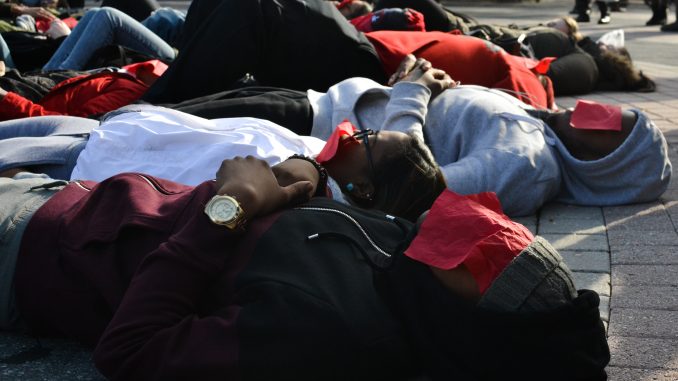
A group of around 75 people marched around campus following the grand jury decisions in the cases of Michael Brown and Eric Garner, two African-American men who died after what protesters said was the result of improper police conduct.
The group, which was organized by Temple’s Black Student Union, started its rally in front of the 7-Eleven on Liacouras Walk, before convening at Paley Library’s circulation desk, and then spending a few moments outside the front entrance of the Student Center at the corner of 13th and Montgomery streets before heading inside. The demonstration concluded around 1 p.m.
At the start of the rally, a “die-in” was staged, where the group lay on the ground and “played dead” for 4.5 minutes, depicting the 4.5 hours Michael Brown laid on the street when he was shot in August. The protesters repeated the action at Paley and in front of the Student Center.
Temple and Philadelphia police were present for the demonstrations.
Sophia Felder, who serves as executive vice president of Temple’s chapter of the Delta Sigma Theta sorority, said the main message of the protest was not about race, but rather a call for justice.
“We can’t let things like this go unnoticed,” Felder said. “It’s not more so of on race or a play on the injustice that’s been happening, it’s just a collective [issue] across the [global spectrum]. It’s just not right.”
The protest most recently follows a grand jury decision Wednesday involving 43-year-old Eric Garner, who died of asphyxiation in July after 29-year-old New York City police officer Daniel Pantaleo held him in a chokehold. Garner repeatedly indicated that he could not breathe in the incident, which was caught on camera.
Felder said holding police accountable is key in light of the incident.
“[There] needs to be more on-body cameras, and more on-vehicle cameras to show what’s going on,” Felder said. “This can be one case of thousands that we don’t even know about. What happens to those people’s voices that aren’t heard? We need to know about all of those cases … so we’re not just singling out one case.”
Mathos Sokolo, the historian and chaplain of Alpha Phi Alpha, agreed with Felder, addressing the crowd inside the Student Center. He called for taking initiative and responding to acts of injustice throughout the country.
“At the end of the day, whether you march or not, it comes down to what you do tomorrow,” Sokolo said in a speech.

Sokolo told The Temple News that his message is vital to preventing future acts of injustice from occurring in communities around the nation.
“It doesn’t take much,” Sokolo said. “We all have things we have to do, [and] we want to do … But we have to do these things in order to maintain balance in life in general … It doesn’t much to take 15, 20 minutes out of your day to march and protest … injustice.”
After Sokolo finished talking to the crowd, a silent prayer was held for Brown, Garner and their families.
The 18-year-old Brown was shot to death in Ferguson, Missouri by Officer Darren Wilson, who has resigned since the grand jury declined to indict him on Nov. 24. Garner was stopped in New York City for selling untaxed cigarettes and during his arrest was placed in the chokehold that eventually killed him.
A vigil set in honor of the two will take place next Tuesday at 6 p.m. at the Bell Tower.
Steve Bohnel can be reached at steven.bohnel@temple.edu or on Twitter @Steve_Bohnel.
Jenny Kerrigan contributed reporting.


The August 9, 2014 shooting of Michael Brown in Ferguson, MO by Officer Darren Wilson was the origin of a national myth. Myths are sacred stories that serve to explain the world view of a people. They often originate as distorted accounts of real historical events that storytellers repeatedly elaborate on until the primary figure in the account achieves the status of a saint or a god. A culture’s myths provide a sense of identity, shared lifestyle, affirm beliefs and values and are expressed in symbols and rituals. A national myth is a fictional narrative that omits important historical details, or adds details where there is no evidence, but is held as true due to its symbolic meaning for the nation. Michael Brown has become the symbol of racism, police brutality and social injustice. Evidence is irrelevant because myths are symbolic not literal truths.
Disregarding forensic evidence and a grand jury decision is necessary and required to perpetuate the national myth of institutionalized racism, oppression and inequality. The mythology functions as a method to demonize police, inculcate fear, justify violence, promote vengeance and achieve political agendas. The death of Michael Brown has been formatted and packaged by the mainstream media that serve as an outlet for state-sponsored propaganda. Correspondents use selective and biased reporting to propagate the national mythology. However, protest signs, graffiti, hand signs, flags, masks and other symbols in Ferguson reveal a different alternative narrative.